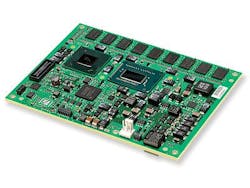One of the biggest trends I’ve seen over the past couple of years has been the advance of embedded consumer technologies into the industrial space. (Links to other recent Automation World coverage of this topic can be found at the bottom of this article). Now comes news that GE Intelligent Platforms will develop a range of rugged COM Express modules based on the new AMD Embedded G-Series SOC (system on a chip) processors.
GE Intelligent Platforms’ rugged COM Express modules are targeted at OEMs and system integrators designing computing platforms into equipment for industrial or harsh environments. Differing from modules designed for benign environments, the processor and memory on GE COM Express modules are soldered to the board for maximum resistance to shock and vibration. GE says extended mechanical construction protects the module, which is designed for optional conformal coating for even greater resistance to moisture, dust, chemicals, and temperature extremes.
Use of the new AMD processors enabled GE to develop more compact modules in what is known as the ‘mini’ format for use in a broader range of environments.
"The AMD Embedded G-Series SOC processors offer a small footprint, low-energy use, and rich I/O integration to enable smaller form factor embedded designs, cool and efficient operation, and simplified build requirements,” said Kamal Khouri, director of embedded products at AMD.
“AMD’s new embedded computing processor technology … enables us to design COM Express modules that require fewer supporting chips, making the modules more compact, requiring less power and dissipating less heat and maximizing reliability and uptime,” said Tommy Swigart, product manager, Control & Communication Systems at GE Intelligent Platforms.
A significant aspect of the COM Express embedded computing architecture, according to GE, lies in how it separates the underlying “carrier card” from the processor. GE says the benefit of this separation is that the processor alone can be upgraded as necessary, thereby reducing the long-term cost of ownership while ensuring that performance keeps pace with customers’ changing needs.
Initial shipments of the new AMD-enabled COM Express modules are expected in late 2013.
Recent Automation World coverage of the embedded space:
Leaders relevant to this article:


